大学英语精读材料2015版 复习重点
- 格式:doc
- 大小:193.50 KB
- 文档页数:24
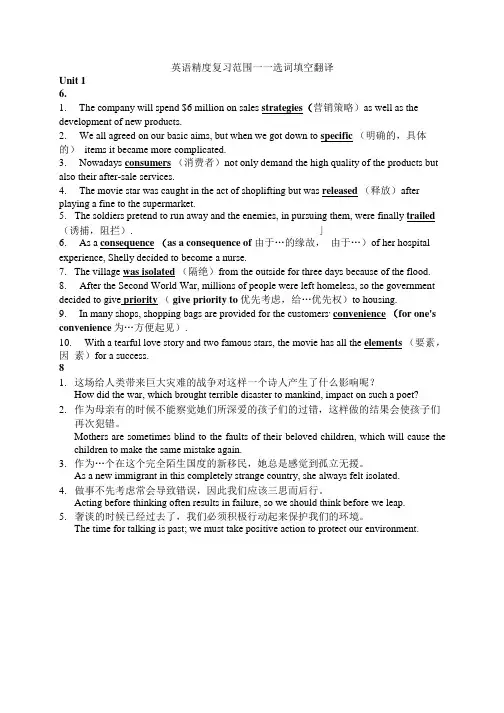
英语精度复习范围一一选词填空翻译Unit 16.1.The company will spend $6 million on sales strategies(营销策略)as well as the development of new products.2.We all agreed on our basic aims, but when we got down to specific (明确的,具体的)items it became more complicated.3.Nowadays consumers (消费者)not only demand the high quality of the products but also their after-sale services.4.The movie star was caught in the act of shoplifting but was released (释放)after playing a fine to the supermarket.5.The soldiers pretend to run away and the enemies, in pursuing them, were finally trailed (诱捕,阻拦). 」6.As a consequence (as a consequence of 由于…的缘故,由于…)of her hospital experience, Shelly decided to become a nurse.7.The village was isolated (隔绝)from the outside for three days because of the flood.8.After the Second World War, millions of people were left homeless, so the government decided to give priority (give priority to 优先考虑,给…优先权)to housing.9.In many shops, shopping bags are provided for the customers,convenience (for one's convenience为…方便起见).10.With a tearful love story and two famous stars, the movie has all the elements (要素,因素)for a success.81.这场给人类带来巨大灾难的战争对这样一个诗人产生了什么影响呢?How did the war, which brought terrible disaster to mankind, impact on such a poet?2.作为母亲有的时候不能察觉她们所深爱的孩子们的过错,这样做的结果会使孩子们再次犯错。
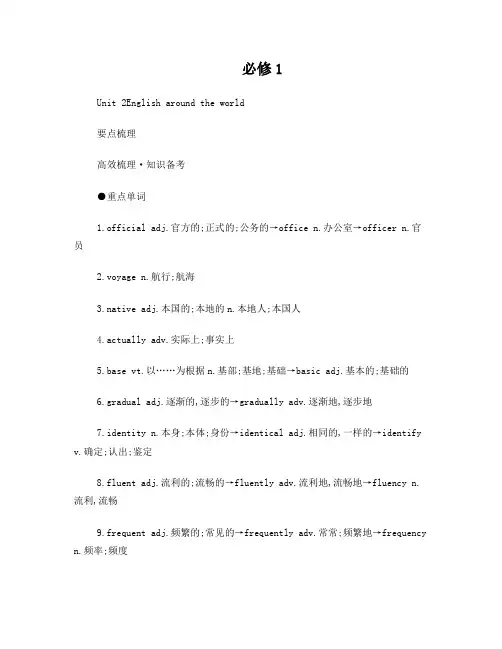
必修1Unit 2English around the world要点梳理高效梳理·知识备考●重点单词1.official adj.官方的;正式的;公务的→office n.办公室→officer n.官员2.voyage n.航行;航海3.native adj.本国的;本地的n.本地人;本国人4.actually adv.实际上;事实上5.base vt.以……为根据n.基部;基地;基础→basic adj.基本的;基础的6.gradual adj.逐渐的,逐步的→gradually adv.逐渐地,逐步地7.identity n.本身;本体;身份→identical adj.相同的,一样的→identify v.确定;认出;鉴定8.fluent adj.流利的;流畅的→fluently adv.流利地,流畅地→fluency n.流利,流畅9.frequent adj.频繁的;常见的→frequently adv.常常;频繁地→frequency n.频率;频度age n.使用;用法;词语惯用法→useful a dj.有用的→use n. & v.使用,利用mand n. & vt.命令;指令;掌握→commander n.指挥员,司令员12.request n.& vt.请求;要求13.expression n.词语;表示;表达→express v.表达→expressive adj.富于表情的;有表现力的14.recognize vt.辨认出;承认;公认→recognizable adj.容易认出的;易于识别的→recognition n.认出;认识;识别15.accent n.口音;腔调;重音16.lightning n.闪电17.straight adv.直接地;挺直地adj.直的;笔直的;正直的●重点短语1.because of由于;因为e up走近;上来3.at present 现在;目前4.make use of 利用5.such as例如……;像这种的6.play a part in 扮演一个角色;参与7.ever before 从前8.even if/though即使9.be based on以……为基础10.over time 长期以来11.in the early days 在早期12.the same as相同于●重点句型1.Today, more people speak English as their first, second or a foreign language than ever before.如今说英语的人比以往任何时候都多,他们有的把英语作为第一语言来说,有的把它作为第二语言或外语。
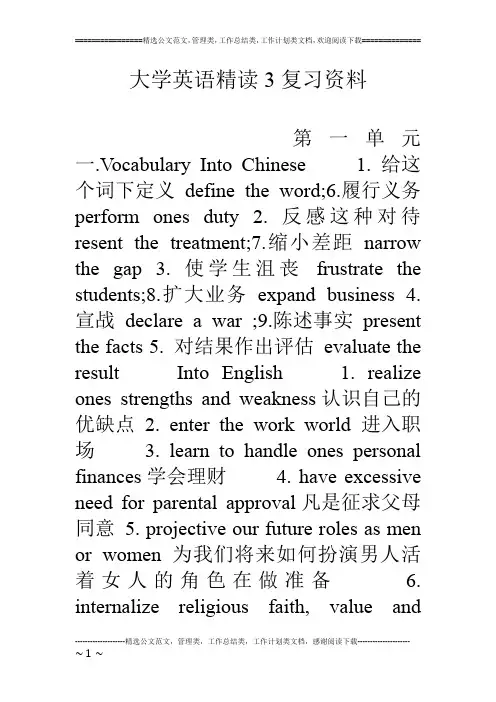
大学英语精读3复习资料第一单元一.V ocabulary Into Chinese 1. 给这个词下定义define the word;6.履行义务perform ones duty 2. 反感这种对待resent the treatment;7.缩小差距narrow the gap 3. 使学生沮丧frustrate the students;8.扩大业务expand business 4. 宣战declare a war ;9.陈述事实present the facts 5. 对结果作出评估evaluate the result Into English 1. realize ones strengths and weakness认识自己的优缺点2. enter the work world 进入职场 3. learn to handle ones personal finances学会理财 4. have excessive need for parental approval凡是征求父母同意5. projective our future roles as men or women 为我们将来如何扮演男人活着女人的角色在做准备 6. internalize religious faith, value andmorals 逐步培养和建立自己的宗教信仰、道德和价值观念。
7. learn to choose ones wardrobe学会选择着装8. establish ones identity 确定个人身份9. question and rebel against old ideas 怀疑并反抗就观念10. defy and challenge authority 蔑视挑战权威二.翻译1.他对他的研究如此专心致志,从来没有过很快就要退休的念头。
He is so devoted to his research that it never occurs to him that he will soon have to retire.2.很多人都曾说过,如果没有有效的制约,我们都有滥用权力的倾向。
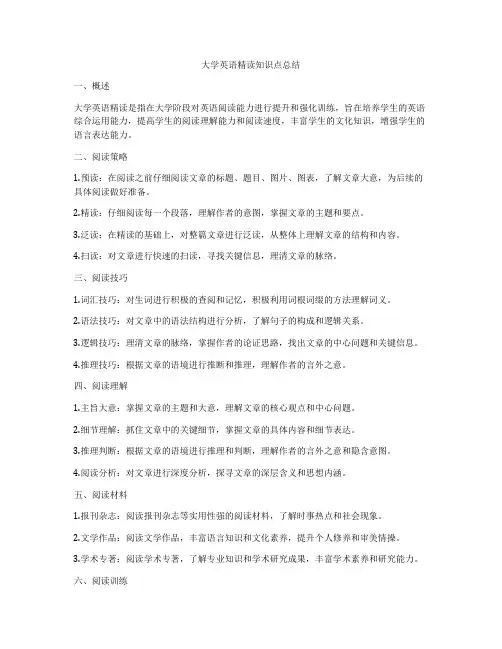
大学英语精读知识点总结一、概述大学英语精读是指在大学阶段对英语阅读能力进行提升和强化训练,旨在培养学生的英语综合运用能力,提高学生的阅读理解能力和阅读速度,丰富学生的文化知识,增强学生的语言表达能力。
二、阅读策略1.预读:在阅读之前仔细阅读文章的标题、题目、图片、图表,了解文章大意,为后续的具体阅读做好准备。
2.精读:仔细阅读每一个段落,理解作者的意图,掌握文章的主题和要点。
3.泛读:在精读的基础上,对整篇文章进行泛读,从整体上理解文章的结构和内容。
4.扫读:对文章进行快速的扫读,寻找关键信息,理清文章的脉络。
三、阅读技巧1.词汇技巧:对生词进行积极的查阅和记忆,积极利用词根词缀的方法理解词义。
2.语法技巧:对文章中的语法结构进行分析,了解句子的构成和逻辑关系。
3.逻辑技巧:理清文章的脉络,掌握作者的论证思路,找出文章的中心问题和关键信息。
4.推理技巧:根据文章的语境进行推断和推理,理解作者的言外之意。
四、阅读理解1.主旨大意:掌握文章的主题和大意,理解文章的核心观点和中心问题。
2.细节理解:抓住文章中的关键细节,掌握文章的具体内容和细节表达。
3.推理判断:根据文章的语境进行推理和判断,理解作者的言外之意和隐含意图。
4.阅读分析:对文章进行深度分析,探寻文章的深层含义和思想内涵。
五、阅读材料1.报刊杂志:阅读报刊杂志等实用性强的阅读材料,了解时事热点和社会现象。
2.文学作品:阅读文学作品,丰富语言知识和文化素养,提升个人修养和审美情操。
3.学术专著:阅读学术专著,了解专业知识和学术研究成果,丰富学术素养和研究能力。
六、阅读训练1.速读训练:通过大量的速读练习,提高阅读速度和阅读效率,加快阅读响应和理解反应。
2.词汇训练:通过大量的词汇积累和词汇训练,丰富词汇量,提高单词记忆和理解能力。
3.语法训练:通过语法练习和语法分析,巩固语法知识,提高语法运用和理解能力。
4.频繁阅读:通过频繁的阅读练习,不断提高阅读水平和阅读能力,培养阅读兴趣和习惯。
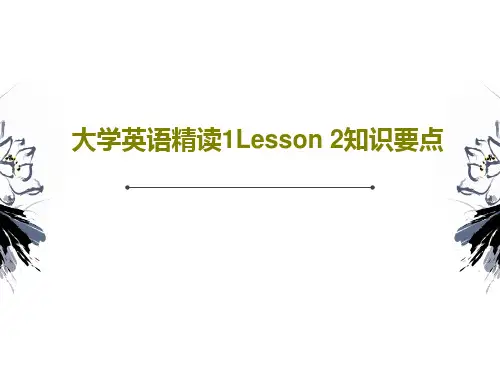
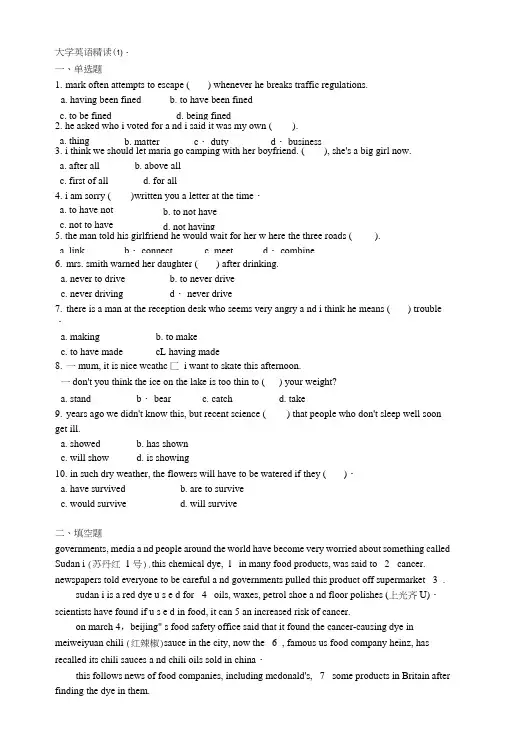
大学英语精读(1)・一、单选题1.mark often attempts to escape ( ) whenever he breaks traffic regulations.a. having been finedb. to have been finedc. to be finedd. being fined2. he asked who i voted for a nd i said it was my own ( ).a. thingb. matter c・ duty d・ business3. i think we should let maria go camping with her boyfriend. ( ), she's a big girl now.a. after allc. first of all4. i am sorry (a. to have not c. not to haveb. above alld. for all)written you a letter at the time・b. to not haved. not having5. the man told his girlfriend he would wait for her w here the three roads ( ).a. link b・ connect c. meet d・ combine6.mrs. smith warned her daughter ( ) after drinking.a. never to driveb. to never drivec. never driving d・ never drive7.there is a man at the reception desk who seems very angry a nd i think he means ( ) trouble ・a. makingb. to makec. to have made cL having made8.一mum, it is nice wcathc匚i want to skate this afternoon.一don't you think the ice on the lake is too thin to ( ) your weight?a. stand b・ bear c. catch d. take9.years ago we didn't know this, but recent science ( ) that people who don't sleep well soon get ill.a. showedb. has shownc. will showd. is showing10.in such dry weather, the flowers will have to be watered if they ( )・a. have survivedb. are to survivec. would survived. will survive二、填空题governments, media a nd people around the world have become very worried about something called Sudan i (苏丹红1 号).this chemical dye,_l_ in many food products, was said to _2_ cancer. newspapers told everyone to be careful a nd governments pulled this product off supermarket _3_.sudan i is a red dye u s e d for _4_ oils, waxes, petrol shoe a nd floor polishes (上光齐U)・scientists have found if u s e d in food, it can 5 an increased risk of cancer.on march 4,beijing" s food safety office said that it found the cancer-causing dye in meiweiyuan chili (红辣椒)sauce in the city, now the _6_, famous us food company heinz, has recalled its chili sauces a nd chili oils sold in china・this follows news of food companies, including mcdonald's, _7_ some products in Britain after finding the dye in them.france was the first to 8 the chemical dye in 2003・ since then , foods 9 Sudan i have been banned in the european union._10_ experts say that people who have eaten any of the products should not _11_ too much, the cancer risk f rom Sudan i is very _12_, as only tiny amounts of it are used in foods.Sudan i was banned f rom food products because experiments on rats _13_ that it could cause serious tumors (肿瘤)•but, al an boobies, an expert in london, says there is little _14_ for the public to worry, he said that the levels fed to the rats were in much, much bigger amounts _15_their body size, the amounts in food products eaten by humans are _16_・the rats that got tumors were given 30 milligrams of Sudan i per kilogram of body weight, every day for two years. animals given half the amount showed no _17_ of cance匚the tumors only _18_ in the rats after many months, for humans, this means that if the dye were to have any _19_, it would take around 20 years・ professor boobis gives a _20_・"it's just like the cancer risk linked with smoking just one cigarette in a lifetime,M he said.1. a. stuck b. stored c. found d. offered2. a. produce b. cause c. make d. give3・ a. shelves b. cases c. storage d. tables4. a. gluing b・ gathering c. coloring d. conducting5. a. allow for b. adjust to c. call for d. contribute to6. a. seller b. producer c. customer d・ farmer7. a. breaking up b. putting out c. pulling away d. taking back8. a. reject b. invent c. notice d・ produce9. a. causing b. including c. containing d・ using10. a. but b. also c. then d. so11 ・ a. complain b. disagree c. worry d・ blame12. a. high b. low c. common d. rare13. a. guided b. guaranteed c. rated d・ showed14. a. concern b. reason c. cause d. right15. a. compared to b. regardless of c. u s e d to d. in spite of16. a. none b. larger c. tiny d. more17. a. signals b. marks c. symbols d. signs18> a・ produced b. developed c. made d. created19. a. effect b. cause c. harm d. change20・ a. connection b. perception c. recognition d. comparison1 一5 • cbacd6一10 bdcca 11 一15 cbdba 16一20 edbad三、翻译题1、那个经理亲自调查产品的质量问题。
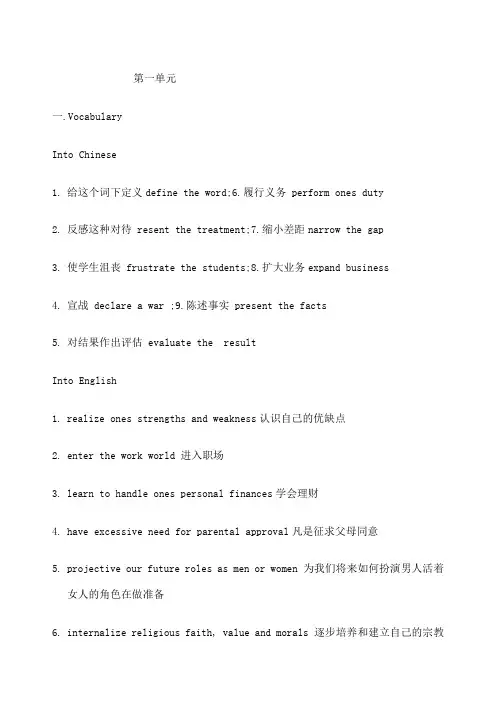
第一单元一.VocabularyInto Chinese1.给这个词下定义define the word;6.履行义务 perform ones duty2.反感这种对待 resent the treatment;7.缩小差距narrow the gap3.使学生沮丧 frustrate the students;8.扩大业务expand business4.宣战 declare a war ;9.陈述事实 present the facts5.对结果作出评估 evaluate the resultInto English1.realize ones strengths and weakness认识自己的优缺点2.enter the work world 进入职场3.learn to handle ones personal finances学会理财4.have excessive need for parental approval凡是征求父母同意5.projective our future roles as men or women 为我们将来如何扮演男人活着女人的角色在做准备6.internalize religious faith, value and morals 逐步培养和建立自己的宗教信仰、道德和价值观念。
7.learn to choose ones wardrobe学会选择着装8.establish ones identity 确定个人身份9.question and rebel against old ideas 怀疑并反抗就观念10.defy and challenge authority 蔑视挑战权威二.翻译1.他对他的研究如此专心致志,从来没有过很快就要退休的念头。
He is so devoted to his research that it never occurs to him that he will soon have to retire.2.很多人都曾说过,如果没有有效的制约,我们都有滥用权力的倾向。
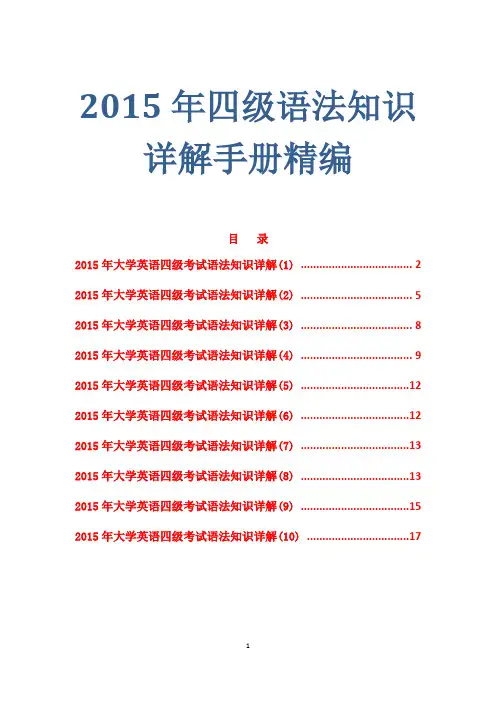
2015年四级语法知识详解手册精编目录2015年大学英语四级考试语法知识详解(1) (2)2015年大学英语四级考试语法知识详解(2) (5)2015年大学英语四级考试语法知识详解(3) (8)2015年大学英语四级考试语法知识详解(4) (9)2015年大学英语四级考试语法知识详解(5) (12)2015年大学英语四级考试语法知识详解(6) (12)2015年大学英语四级考试语法知识详解(7) (13)2015年大学英语四级考试语法知识详解(8) (13)2015年大学英语四级考试语法知识详解(9) (15)2015年大学英语四级考试语法知识详解(10) (17)2015年大学英语四级考试语法知识详解(1)英语冠词冠词分不定冠词(indefinite article)和定冠词(definite article)两种,一般无句子重音。
1)不定冠词a,ana) a和an均用在单数名词之前,表示某一类人或事物中的"一个",相当于汉语的"一",但不强调数目观念。
b) a用在辅音之前,an用在元音之前。
如:a notebook一个笔记本,a cigarette一支香烟,an old man一位老人,an English class一堂英语课。
字母u读作[ju:]时,由于第一个音[j]是辅音,故前面用a,不用an。
如:a useful book一本有用的书,a university一所大学。
字母h如不发音,第一个音又是元音,前面用an而不用a,如an hour [?n'au?]一小时,an honest [?n' nist] person一个诚实的人。
c) a和an在句中分别弱读作[E]和[En]。
2)定冠词thea)表示某一类人或事物中的"某一个"或"某一些",相当于汉语的"这"或"那"。
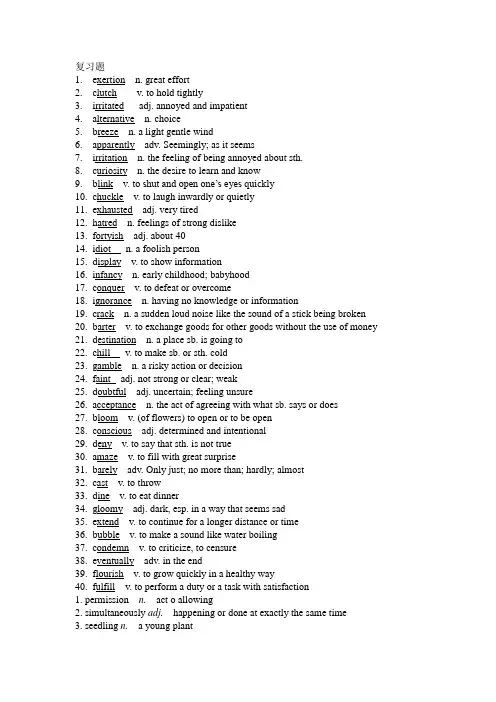
复习题1.exertion n. great effort2.clutch v. to hold tightly3.irritated adj. annoyed and impatient4.alternative n. choice5.breeze n. a light gentle wind6.apparently adv. Seemingly; as it seems7.irritation n. the feeling of being annoyed about sth.8.curiosity n. the desire to learn and know9.blink v. to shut and open one’s eyes quickly10.chuckle v. to laugh inwardly or quietly11.exhausted adj. very tired12.hatred n. feelings of strong dislike13.fortyish adj. about 4014.idiot n. a foolish person15.display v. to show information16.infancy n. early childhood; babyhood17.conquer v. to defeat or overcome18.ignorance n. having no knowledge or information19.crack n. a sudden loud noise like the sound of a stick being broken20.barter v. to exchange goods for other goods without the use of money21.destination n. a place sb. is going to22.chill v. to make sb. or sth. cold23.gamble n. a risky action or decision24.faint adj. not strong or clear; weak25.doubtful adj. uncertain; feeling unsure26.acceptance n. the act of agreeing with what sb. says or does27.bloom v. (of flowers) to open or to be open28.conscious adj. determined and intentional29.deny v. to say that sth. is not true30.amaze v. to fill with great surprise31.barely adv. Only just; no more than; hardly; almost32.cast v. to throw33.dine v. to eat dinner34.gloomy adj. dark, esp. in a way that seems sad35.extend v. to continue for a longer distance or time36.bubble v. to make a sound like water boiling37.condemn v. to criticize, to censure38.eventually adv. in the end39.flourish v. to grow quickly in a healthy way40.fulfill v. to perform a duty or a task with satisfaction1. permission n.act o allowing2. simultaneously adj.happening or done at exactly the same time3. seedling n. a young plant4. patch n. a small area of ground5. warder n.the head of a prison6. oddly adv.Unusually; in an unusual way7. release v. to let go; to stop holding sth.8. spectator n.(here) an onlooker9. motto n. a short statement used as a guide to behavior.10. recall v.to remember sth.11. shabby adj.in bad repair or condition often due to age12. rarely adv.not very often13. numerous adj.many; countless14. perspective n. a way of thinking about of looking at sth.15. spout v.gush; squirt; to send out with great force16. unexpected adj.not anticipated17. soar v.to fly high up in the sky18. sincerity n.the quality of being honest and true19. thorn n.sharp pointed growth on a plant20. wretched adj..very unhappy21. sill n.the narrow shelf at the base of a window frame22. sloppy adj.careless about clothes23. slender adj. slim24. thrill n. a sudden strong feeling of excitement or pleasure25. replace v.to take the place of26. scent n. a pleasant smell27. strip n. a narrow piece28. textile n.any material made by weaving29. mustache n.hair growing on a man’s upper lip30. passion n.very strong feelings(of hate, anger, love)31. protest v.to complain32. withdrawal n.the act of taking money out of a bank account33. revolve v.to move or turn in a circle around a central point34. misgivings n.(pl.)feelings of doubt and fear35. startled adj. surprised and often slightly frightened36. opportunity n. a chance37. nap n. a short sleep38. shimmer v.to shine with a soft trembling light39. topmost adj.highest40. murmur v.to say sth. In a soft quiet voice that is difficult to hear clearly II. Complete the sentences, using the proper form of the expressions listed below. III. Fill in the blanks with the correct prepositions or adverbs. (1'×10=10')IV.Reading (20%)V.Translation (25′) 汉译英(书后)英译汉课文段落。
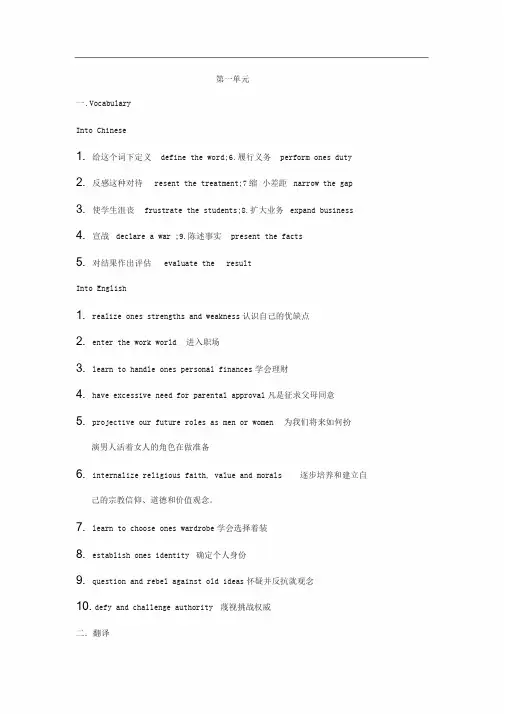

复习题1.exertion n. great effort2.clutch v. to hold tightly3.irritated adj. annoyed and impatient4.alternative n. choice5.breeze n. a light gentle wind6.apparently adv. Seemingly; as it seems7.irritation n. the feeling of being annoyed about sth.8.curiosity n. the desire to learn and know9.blink v. to shut and open one’s eyes quickly10.chuckle v. to laugh inwardly or quietly11.exhausted adj. very tired12.hatred n. feelings of strong dislike13.fortyish adj. about 4014.idiot n. a foolish person15.display v. to show information16.infancy n. early childhood; babyhood17.conquer v. to defeat or overcome18.ignorance n. having no knowledge or information19.crack n. a sudden loud noise like the sound of a stick being broken20.barter v. to exchange goods for other goods without the use of money21.destination n. a place sb. is going to22.chill v. to make sb. or sth. cold23.gamble n. a risky action or decision24.faint adj. not strong or clear; weak25.doubtful adj. uncertain; feeling unsure26.acceptance n. the act of agreeing with what sb. says or does27.bloom v. (of flowers) to open or to be open28.conscious adj. determined and intentional29.deny v. to say that sth. is not true30.amaze v. to fill with great surprise31.barely adv. Only just; no more than; hardly; almost32.cast v. to throw33.dine v. to eat dinner34.gloomy adj. dark, esp. in a way that seems sad35.extend v. to continue for a longer distance or time36.bubble v. to make a sound like water boiling37.condemn v. to criticize, to censure38.eventually adv. in the end39.flourish v. to grow quickly in a healthy way40.fulfill v. to perform a duty or a task with satisfaction1. permission n.act o allowing2. simultaneously adj.happening or done at exactly the same time3. seedling n. a young plant4. patch n. a small area of ground5. warder n.the head of a prison6. oddly adv.Unusually; in an unusual way7. release v. to let go; to stop holding sth.8. spectator n.(here) an onlooker9. motto n. a short statement used as a guide to behavior.10. recall v.to remember sth.11. shabby adj.in bad repair or condition often due to age12. rarely adv.not very often13. numerous adj.many; countless14. perspective n. a way of thinking about of looking at sth.15. spout v.gush; squirt; to send out with great force16. unexpected adj.not anticipated17. soar v.to fly high up in the sky18. sincerity n.the quality of being honest and true19. thorn n.sharp pointed growth on a plant20. wretched adj..very unhappy21. sill n.the narrow shelf at the base of a window frame22. sloppy adj.careless about clothes23. slender adj. slim24. thrill n. a sudden strong feeling of excitement or pleasure25. replace v.to take the place of26. scent n. a pleasant smell27. strip n. a narrow piece28. textile n.any material made by weaving29. mustache n.hair growing on a man’s upper lip30. passion n.very strong feelings(of hate, anger, love)31. protest v.to complain32. withdrawal n.the act of taking money out of a bank account33. revolve v.to move or turn in a circle around a central point34. misgivings n.(pl.)feelings of doubt and fear35. startled adj. surprised and often slightly frightened36. opportunity n. a chance37. nap n. a short sleep38. shimmer v.to shine with a soft trembling light39. topmost adj.highest40. murmur v.to say sth. In a soft quiet voice that is difficult to hear clearly II. Complete the sentences, using the proper form of the expressions listed below. III. Fill in the blanks with the correct prepositions or adverbs. (1'×10=10')IV.Reading (20%)V.Translation (25′) 汉译英(书后)英译汉课文段落。
第一单元一.VocabularyInto Chinese1.给这个词下定义define the word;6.履行义务 perform ones duty2.反感这种对待 resent the treatment;7.缩小差距narrow the gap3.使学生沮丧 frustrate the students;8.扩大业务expand business4.宣战 declare a war ;9.陈述事实 present the facts5.对结果作出评估 evaluate the resultInto English1.realize ones strengths and weakness认识自己的优缺点2.enter the work world 进入职场3.learn to handle ones personal finances学会理财4.have excessive need for parental approval凡是征求父母同意5.projective our future roles as men or women 为我们将来如何扮演男人活着女人的角色在做准备6.internalize religious faith, value and morals 逐步培养和建立自己的宗教信仰、道德和价值观念。
7.learn to choose ones wardrobe学会选择着装8.establish ones identity 确定个人身份9.question and rebel against old ideas 怀疑并反抗就观念10.defy and challenge authority 蔑视挑战权威二.翻译1.他对他的研究如此专心致志,从来没有过很快就要退休的念头。
He is so devoted to his research that it never occurs to him that he will soon have to retire.2.很多人都曾说过,如果没有有效的制约,我们都有滥用权力的倾向。
复习题1.exertion n. great effort2.clutch v. to hold tightly3.irritated adj. annoyed and impatient4.alternative n. choice5.breeze n. a light gentle wind6.apparently adv. Seemingly; as it seems7.irritation n. the feeling of being annoyed about sth.8.curiosity n. the desire to learn and know9.blink v. to shut and open one’s eyes quickly10.chuckle v. to laugh inwardly or quietly11.exhausted adj. very tired12.hatred n. feelings of strong dislike13.fortyish adj. about 4014.idiot n. a foolish person15.display v. to show information16.infancy n. early childhood; babyhood17.conquer v. to defeat or overcome18.ignorance n. having no knowledge or information19.crack n. a sudden loud noise like the sound of a stick being broken20.barter v. to exchange goods for other goods without the use of money21.destination n. a place sb. is going to22.chill v. to make sb. or sth. cold23.gamble n. a risky action or decision24.faint adj. not strong or clear; weak25.doubtful adj. uncertain; feeling unsure26.acceptance n. the act of agreeing with what sb. says or does27.bloom v. (of flowers) to open or to be open28.conscious adj. determined and intentional29.deny v. to say that sth. is not true30.amaze v. to fill with great surprise31.barely adv. Only just; no more than; hardly; almost32.cast v. to throw33.dine v. to eat dinner34.gloomy adj. dark, esp. in a way that seems sad35.extend v. to continue for a longer distance or time36.bubble v. to make a sound like water boiling37.condemn v. to criticize, to censure38.eventually adv. in the end39.flourish v. to grow quickly in a healthy way40.fulfill v. to perform a duty or a task with satisfaction1. permission n.act o allowing2. simultaneously adj.happening or done at exactly the same time3. seedling n. a young plant4. patch n. a small area of ground5. warder n.the head of a prison6. oddly adv.Unusually; in an unusual way7. release v. to let go; to stop holding sth.8. spectator n.(here) an onlooker9. motto n. a short statement used as a guide to behavior.10. recall v.to remember sth.11. shabby adj.in bad repair or condition often due to age12. rarely adv.not very often13. numerous adj.many; countless14. perspective n. a way of thinking about of looking at sth.15. spout v.gush; squirt; to send out with great force16. unexpected adj.not anticipated17. soar v.to fly high up in the sky18. sincerity n.the quality of being honest and true19. thorn n.sharp pointed growth on a plant20. wretched adj..very unhappy21. sill n.the narrow shelf at the base of a window frame22. sloppy adj.careless about clothes23. slender adj. slim24. thrill n. a sudden strong feeling of excitement or pleasure25. replace v.to take the place of26. scent n. a pleasant smell27. strip n. a narrow piece28. textile n.any material made by weaving29. mustache n.hair growing on a man’s upper lip30. passion n.very strong feelings(of hate, anger, love)31. protest v.to complain32. withdrawal n.the act of taking money out of a bank account33. revolve v.to move or turn in a circle around a central point34. misgivings n.(pl.)feelings of doubt and fear35. startled adj. surprised and often slightly frightened36. opportunity n. a chance37. nap n. a short sleep38. shimmer v.to shine with a soft trembling light39. topmost adj.highest40. murmur v.to say sth. In a soft quiet voice that is difficult to hear clearly II. Complete the sentences, using the proper form of the expressions listed below. III. Fill in the blanks with the correct prepositions or adverbs. (1'×10=10')IV.Reading (20%)V.Translation (25′) 汉译英(书后)英译汉课文段落。
Test OnePart 1: VocabularyFill in each of the blanks in the following sentences with a word or phrase from the box below. Change the forms where necessary.1.Many of the students ______ that the exam was too hard.2.Can you turn the music down, please? I can’t ______ on my work.3.You ______ fail the exam if you don’t do any revision.4.At first, Tom found it difficult to ______ what his teachers said in class.5.After spending a year in Australia, the little girl has gained quite a good ______ of spoken English.6.The newly-elected government has begun the painful ______ of working out its policies and strategies.7.______ being fun and good exercise, swimming is a very useful skill.8.After explaining his plan in great detail, Bob ______ its main points in a few sentences.9.Young as she is, Mary is very good at ______ difficult customers.10.The marketing department is working on new ______ to improve the company’s share of the market.Part 2: Paragraph Information MatchingIn this section, you are going to read a passage with ten statements attached to it. Each statement contains information given in one of the paragraphs. Identify the paragraph from which the information is derived. You may choose a paragraph more than once.The Truth about Sports and Weight LossBy Katrina CollinsDangers of Extreme Weight Loss and Gain in MMA.A)According to a study by Michelle T. Barrack from the University of California, Davis, and her colleagues, "Teenagegirls who stringently restrict their energy intake while involved in endurance sports may end up with low bone density.Preliminary evidence from a study involving 93 female high school cross-country runners shows an association between low bone mass values and more intensive dietary restraint, according to a report in the American Journal of Clinical Nutrition."B) For the 13-to-18 year-old athletes assessed, investigators defined high levels of dietary restriction as "girls who reportednot eating for 8 hours or more, consciously restricting amounts or types of food, and following strict calorie or serving size limits for 16 days or longer during the month."C) Measurements of the girls’ bone mineral density in the lower spine and thighbone (股骨) were recorded, and the resultswere not surprising —they found that the girls with increased dietary restraint had the lowest bone mass values.Conversely, the study found that "weight or shape concerns in the absence of dietary restraint practices were not associated with low bone mass."D) According to Barrack, "These findings suggest that young runners and their support system, including parents, coaches,and athletic trainers, should make sure that girls expending hundreds of calories on a daily basis are not stringently restricting their energy intake." The same could be said about young women in mixed martial arts (MMA).E) Many females are taking up martial arts and in particular, MMA. While MMA is one of the fastest growing sports in theworld today, female fighters are still struggling with finding fights. They want to fight but the problem is finding worthy opponents and available venues. Oftentimes, in order to compete, they're forced to quickly reduce or increase their weight to accommodate another fighter and fit into their weight class. This may be an easy thing to do when you're 18, 21, or 25 and in fact you may not even feel the damage done to your body during this time. But you will feel the results as you get older. Your bones will become brittle and break easily. As a fighter in MMA, this should be the last thing you want to have happen.F) This leads to the question: are there other options available? YES! As an athlete, and as a fighter, you actually have a lotof options. The first, of course, is to "just say no"! If an event promoter calls you to fight at below or above your normal weight, say NO. Even if your manager or agent asks you to change your weight, don't do it. And if they do, go find another manager. I don't know about you, but I'd rather have someone who had my best interests at heart, not theirs. It's one of the reasons why you're paying them. So don't get caught up into that trap. If enough of us keep saying "NO", they'll stop asking, and instead will be forced to look for and find two fighters who are starting from the same weight class.G) Don't eat fast foods. Have you seen "Super Size Me" or "Fast Food Nation"? Yeah. Stuff isn't good for you. I mean, thinkabout it. You train all day long, now your body's starving for fuel, and you give it junk. Not just normal junk, but the kind that'll clog up your arteries (动脉), make you sluggish, and kill you. No kidding. According to , fast food places (I refuse to call them restaurants) don't use normal cooking oil which of course is full of fat. Rather, they use a SPECIALL Y-CREATED cooking oil that is generally special hydrogenated (使氢化合物的) cooking oil. Check it out that they even make sure their special cooking oil "undergoes a process designed to increase its shelf life. This process makes it downright dangerous for human consumption as it produces high levels of trans-fats. These fat compounds are barely recognizable as food by the human body and end up getting stored as fat cells or heading right to an artery to start clogging it up." (SOURCE: /dangers-fast-food) And we wonder why we see so many fighters and athletes who are still fat. We wonder ourselves why we're so sluggish.We work out, train hard — and then hit the drive-thru window on the way home. Question answered.H) Do you really want to clog up your arteries? Lose your bone density? Starve yourself? All for the sake of a 15 minutefight? If so, you need to rethink some things.I) How about another option? Eat well and use some good old fashioned common sense by eating "whole" foods. What are the whole foods you ask? I can hear a lot of you right now. "I'm no hippie! I don't want to eat all that organic crap! It's too expensive and I hate that health food stuff! I don't have a health food store in my area!" That's not what I said. I said "whole foods." Whole foods are foods that have undergone very little processing and that have been grown or producedwithout the use of synthetic pesticides or fertilizers. You can find this stuff at your local grocery store! No kidding! It's all found in the fresh food section and in the outskirts of the store. So you need to eat things like fresh vegetables, fruit, nuts, milk, eggs, cheese, yogurt, beans (not the kind in a jar), rice, etc. Think of it this way, whole foods are usually those types of foods that will spoil after a period of time, if you don't refrigerate or eat it. If you stick to these foods, your body will love and reward you! You'll lose weight if you need to, gain weight (unless you're one of those with a really fast metabolism (新陈代谢) and have a hard time gaining ) if you need to, and/or maintain your weight once you get to your optimum level. You'll feel good, train well, sleep well and feel fit and full!J) Another option? Follow a quality nutritional program. (Notice I didn't say "diet" program. Your "diet" is actually what you eat every day. It's not really what you do to lose weight, although that's what we've turned it into. So I don't use the word diet anymore. Nutritional program sounds so much better, don't you think?) Eat healthy. Stick to good, whole foods. Eat what I call "good protein" like nuts and beans with rice. And if you think I'm kidding, ask my friends who've spent any amount of time with me. I drink juice, and I eat a lot of nuts, dates, raisins, and fruit. My body loves that stuff more now than anything! Additionally, I've found that the nutritional plan described by Dr. Robert Haas in his book "Eat to Win the Sports: Nutrition Bible for a New Generation" to be a good one to follow, but that's just my personal opinion. (I'm not endorsing it, just telling you what's worked for me.)K) No matter what, stop starving yourself to lose weight, or piling up the protein and to gain a bunch of weight before a fight. Start eating healthy NOW! Let your body figure out the weight it SHOULD be and stay there. And the next time a promoter asks you to change your weight to accommodate another fighter for an event — JUST SAY NO!______ 1. Female MMA fighters quickly increase or decrease their weight so as to find their proper opponents or fit into their weight class.______ 2. According to a report in the American Journal of Clinical Nutrition, more intensive dietary restraint is associated with low bone mass values in female high-school runners.______ 3. A nutritional program is to stick to good, whole foods, such as nuts and beans with rice.______ 4. It's not recommended to eat fast foods, because they are harmful to our health.______ 5. Whether you are going to gain or lose weight, you should start eating healthy and make it clear about your ideal weight.______ 6. Female MMA fighters shouldn't stringently restrict their energy intake.______ 7. So many fighters and athletes are still fat because of high intake of fast foods.______ 8. Whole foods will benefit human body a lot in the long run.______ 9. Stringent restrictions of energy intake might be the cause of lower bone mass values in the athletes being assessed.______ 10. MMA athletes are supposed to say “NO” when their manager or agent asks them to c hange their weight or fight at below or above their normal weight.Part 3: Reading ComprehensionThere are two passages followed by some multiple choice questions. Choose the best answer for each question. Passage 1Minh Pham was born in Vietnam(越南). He left when he was 21 years old. Minh has been in America for almost two years. There is still much he does not understand about America.Once Minh was in a grocery store. He saw an old man and an old woman. They wanted a box of cereal(麦片). The box w as on a high shelf. The man and woman couldn’t reach it .Minh saw a stepladder. He got on the ladder and got the box. He handed it to the elderly couple. They thanked him.“Where are your children?” asked Minh. “Why don’t they help you buy food?”“Our children have their own lives,” said the man and woman. “We like to be free to do as we like.” Minh doesn’t think this is right. In his country, children help their parents. Minh gave the elderly couple his phone number. He told them to call him if they needed help. One night they asked Minh to dinner, but they never asked him for help.One day, Minh was walking with a Vietnamese friend. The two were going to a film. Minh wanted to go to a restaurant first. Minh took his friend’s hand. He pulled him toward the restaurant. People on the street stared at Minh. In Vietnam, friends often hold hands. Minh found out that people in America are not used to men holding hands.Minh Pham is going through a process known as resocialization (重新与社会公认准则保持一致). Socialization is the process through which a person learns to live in a society. Everyone goes through this process. Minh went through it when he lived in Vietnam. But the Vietnamese way of life is much different from the American way of life. When Minh came to America, he had to learn a new way of life. He had to learn how to live in a new society.Minh has learned a lot about American life in two years. He still has a lot to learn. The process of resocialization can take many years.1. The main idea of the passage is that one should ____________.A. ignore cultural differencesB. learn to live in the new countryC. travel all over the worldD. learn to act on one’s own2. According to the passage, Minh thought the old couple should ____________.A. ask their children for helpB. encourage each other and help each otherC. rely on themselvesD. live a quiet and comfortable life3. The passage tells us that it is necessary for ____________ to learn to live in a new society.A. people who have a hard lifeB. everyone who comes to a new environmentC. Asians who have not learned a foreign language and lack practical experienceD. those who have a smooth life in their own country.4. It seemed that people felt surprised when they saw that Minh and his friend_____.A. were VietnameseB. were immigrants (移民)C. were holding handsD. were quarreling5. It is hard to ____________ when one comes to a new country.A. learn as many foreign languages as possibleB. get used to the local weather and climateC. greet foreignersD. avoid culture shock and get used to the new life Passage 2Someone said to a man, “Travel and see the world.” He answered, “Why should I? People are the same everywhere. They are born. They are babies. They are children. They are adults. They grow old. They die .They have the same feelings. They feel love and hate, happiness and sadness, security and fear, pride and shame. That is why I do not want to travel. I can learn everything here. I’m going to stay home.”The man was right. He was also wrong. People are the same, but people are also different. They all have the same pattern of life — birth, youth, old age and death. But these stages of life have different values in different cultures. Also, while all people have the same feelings, the causes of these feelings are different. A situation that may bring happiness in one place may not bring happiness in another place.For example, in many countries old age is a happy time. Young people in these countries show respect to the old. In Korea, old people are honored and respected. When they are too old to live alone, they live with a son, daughter, or other relatives. When they become 61 years old, it is a very happy and important event. There is a big party with many guests.They receive many gifts. When people reach this time in life, the attitudes of their family and their community change toward them. Their position in life is good because they receive honors and respect. Everyone looks forward to this time.In the United States, it is quite different for old people. Most old people do not live with their children or relatives. For many North Americans, old age is not a happy time. Most North Americans want to stay young. They try to act like young people as long as possible. They even try to speak the language of the young. They do not like to grow old because they will not get honor or respect or attention. Also, businesses do not want old people to work for them. So, old people usually live alone and they do not have many things to do. Old age can be a sad and lonely time for them.6. The reason why the man did not have the intention of travelling was that _____.A. he thought he already knew about people in other places.B. he was too old to travel any moreC. he could not understand people in other countries since he was deafD. he preferred to stay home to enjoy his leisure time.7. Which of the following statements is NOT true?A. People all over the world are the same, but they are also different.B. Different values are reflected in different stages of life in different cultures.C. People react differently to the same situation.D. The reasons for the same feelings are also the same in different cultures.8. In Korea, people__________.A. think being young is the same as being oldB. are afraid of old ageC. are longing for old ageD. value their youth most9. Compared with American old people, the old in Korea _____.A. enjoy living alone and supporting themselves.B. Can lead an honored and respected lifeC. Can act like the youngD. Are not respected and do not receive due attention10. The word “businesses” in Paragraph 4 means_______.A. managersB. consumersC. shops or factoriesD. busy peoplePart 4: ClozeIn this part, you will read a passage with 10 blanks. For each blank there are four choices marked A, B, C and D. You should choose the one that best fits into the passage.Learning (1) help make the difficult task of studying English easier. For instance, it is beneficial to treat new words in different ways according to how (2) they occur in everyday use: active words you must practice over and over again; useful words you must (3) to memory; words that seldom occur in everyday situations require just a nodding (4) . It also pays to watch out (5) idiomatic ways of saying things in English. As idiomatic usage often causes difficulties for Chinese students, you must pay close attention to the way native speakers (6) .Language learning is, in fact, an active (7) . Students who make a conscious effort to practice English, who seek out (8) to use what they have learned, are more successful than those who rely (9) the teacher to do the whole job. Undoubtedly, it is all important to put into practice through speaking and writing what you have (10) from reading and listening.1. A. stages B. strategies C. tragedies D. remedies2. A. rare B. rarely C. frequent D. frequently3. A. commit B. put C. give D. take4. A. assistance B. resistance C. instance D. acquaintance5. A. in B. of C. for D. at6. A. advocate B. complicate C. communicate D. associate7. A. proceed B. precede C. process D. possess8. A. solutions B. conditions C. approaches D. opportunities9. A. on B. in C. at D. to10. A. heard B. absorbed C. practiced D. readPart 5: TranslationComplete the following sentences by translating into English the Chinese given in brackets.1. It is well known that this disease ________________________________________(至少部分地是由于吸烟过多).2. Mary complained that she ____________________________________________(常发现和她女儿无法沟通).3. I hope you can ______________________ (拿出一个比这更好的解决办法).4. __________________________ (当他渐渐获得了信心), his words came out spontaneously.5. These expensive drawings must not _______________________ (直接暴露在阳光之下) .Test TwoPart 1: VocabularyFill in each of the blanks in the following sentences with a word or phrase from the box below. Change the forms where1.Our history professor explained the ______ cause of the First World War.2.As a fireman, you must be ready to ______ hardships and even suffer death.3.I think we should let Mary go camping with her classmates. ______, she is a big girl now.4.After much thought, we ______ agreed to let him go.5.They’ve ______ for her to be operated on by the best doctors.6.Jim had a ______ problem with his car, but he fixed it himself.7.To the old lady’s great ______ , Myra did not come, nor did she send her any present.8.Prof. Smith is not a stranger to us. We’ve met him o several ______.9.He hasn’t got enough clothes on — look, he’s ______ with cold.10.Let’s go to the park. It’s just ______.Part 2: Paragraph Information MatchingIn this section, you are going to read a passage with ten statements attached to it. Each statement contains information given in one of the paragraphs. Identify the paragraph from which the information is derived. You may choose a paragraph more than once.Are You Superstitious?By Cristina NutaA)When was the last time you crossed your fingers or said, "Bless you" to someone who sneezed? Have you felt awfulwhen you've broken a mirror? Do you own a rabbit's foot? Do you get the heebie jeebies on Friday the 13th? If any of the above rings a bell, then join the over 50% of the population who admit to being a bit superstitious.B)It is very well-known that many people nowadays believe in superstitions. For example, Tuesdays are considered to beunlucky days and we expect three bad things to happen to us during such a day. Then, if it is Friday, the thirteenth, other bad happenings will wait for us. Not to forget the owl singing at night just in one of the trees we have near our house, as it will announce that maybe somebody close to us will soon die. But one of the most unlucky signs that something horrible will happen to us in the proximate future is to see a black cat crossing our way. And if that black cat passes in front of us especially before our exam in Math, then it is well-known that our test paper will be a failure.C)Some Superstitions Are Obvious:If you dry your hands on a towel while someone else is using it, you'll fight with that person (probably before your hands are dry)●It's bad luck to leave your house with all the doors open (but good luck for burglars)●Never hit a child with a broom, it will make him stupid (especially if you hit him over the head)●It's bad luck to kick a cat (possibly for you as well as the cat)●It's bad luck to put three lamps on a table (especially if you plug them all into the same power point)●Shoes on a bed will cause a family fight (particularly if they are muddy)D) Some Superstitions Are Surprising:●If you kiss your elbow, you'll change your sex (cheaper than surgery)●If a girl steps over a broom lying on the floor, she'll be a mother before she's a wife (must be a lot of brooms lyingabout)●If you sew on a Sunday you'll have to rip out every stitch with your nose before you can get into heaven (I used totry something similar by telling my kids they'd have to eat their mountain of discarded veggies before they got into heaven — that didn't work either)●You must never greet the sun by speaking to it, e.g. "Hello sun", when it re-appears after being overcast, or it willgo right back into the clouds again. (No wonder it rains so much in Ireland.)●Apparently if you cross your fingers when you tell a lie, it doesn't count against your character. (Someonesuggested that this is why so many politicians keep their hands in their pockets when they speak).E)Superstitions are activities that have no effect on events but exist because of coincidental rewards and society'sprejudices. They are rooted in the philosophy that a symbolic act will bring about a physical reality. In a world where we face so many important and uncertain challenges, superstitions provide the illusion that we can somehow control our fates. We derive comfort from thinking we can either avoid an undesirable result or bring about a desired result.Superstitions reduce tension and give us a sense that what we're doing can help us out. In this way, they can be extremely useful tools.F)Even if you're not a believer, we think you'll get a kick out of some of the behaviors people practice in the hope theywill bring them luck. Throughout history, around the globe, strange rituals live on. In China consumers are willing to pay huge sums of money for the right phone number and will shun others. One businessman paid $20,000 for a number he liked. The worst possible combination is one ending in 547424, because in Chinese it sounds like, "I die, my wife dies, my child dies." In the Philippines, if you're taking a picture with two friends, don't stay in the middle as something bad might happen to you. Position yourself in either the left or right, or better yet add a few more people to the photo.Oh, and never take a bath on the day of your birthday... it brings bad luck. In Cuba if you leave a glass of water at your bedside overnight and there are bubbles in the glass the next morning, you are surrounded by good spirits. Women tend to be significantly more superstitious than men —or at least they admit to it in more studies —and less educated people have more superstitions than better educated. Being superstitious is often a family tradition. If your parents are, chances are you will be too.G)Superstitions help out with the performance anxiety that is an occupational hazard for lots of athletes. Baseball playerWade Boggs has eaten chicken before each game for over twenty years. Basketball player Michael Jordan admits he has to lace up his shoes a certain way before every game. Babe Ruth took a swat at butterflies on the diamond because hewas sure they were bad luck. Hockey legend Wayne Gretzky habitually tucked the right side of his jersey(运动衫) behind his hip pads for luck before every game.H)Weddings are rich in superstitious ritual. A bride wears "something borrowed" from a previous bride who has a happymarriage; she wears "something blue" because it signifies virtue. A Chinese bride is never supposed to look in a mirror to insure there will only be one bride.I)Actors are considered to be in one of the most superstitious professions. Everyone knows you never wish an actor goodluck. Instead you say, "Break a leg." By wishing someone good luck, you're supposed to give your own luck away. Real flowers, jewels, money, mirrors and coffins are considered bad luck onstage. It's good luck if an actor's shoes squeak on his entrance, or if a cat makes its home in the theater. Fear of change is usually at the heart of actors' superstitions. If he has a success on opening night, he hesitates to change anything during the run.J)So superstitions are rooted in the profound lack of self-control we feel, especially in anxious times. Our minds create explanations for phenomena beyond our comprehension. So rub a rabbit's foot and pluck some daisies (he does love you, after all). Especially in today's world, it can't hurt!______ 1. In the Philippines, you are advised not to stand in the middle while taking a photo with two friends, because something bad might happen to you.______ 2. It is an obvious superstition to believe putting shoes on a bed will result in a family fight.______ 3. Over half of the population admitted that they are somehow superstitious.______ 4. Superstitions can be very useful because they can make us less nervous while facing uncertain challenges.______ 5. According to a superstitious belief, seeing a black cat running across your way is an unlucky sign.______ 6. Performance anxiety may be relieved by superstitions for many athletes.______ 7. The author holds the view that never greeting the sun is a surprising superstition.______ 8. Illiterate women are most likely to be superstitious.______ 9. In a wedding ceremony, a bride puts on something blue, which indicates virtue.______ 10. For the phenomena that we fail to comprehend, we create explanations, which become superstitions.Part 3: Reading ComprehensionThere are two passages followed by some multiple choice questions. Choose the best answer for each question. Passage 1The advantages and disadvantages of a large population have long been a subject of discussion among economists. It has been argued that the supply of good land is limited. To feed a large population, poor land must be cultivated(耕种) and the good land worked intensively(精耕细作地). Thus, each person produces less and this means a lower average income than could be obtained with a smaller population. Other economists have argued that a large population gives more chance of development of facilities such as ports, roads, and railways, which are not likely to be built unless there is a big demand.One of the difficulties in carrying out a worldwide birth control grogram lies in the fact that official attitudes to population growth vary(变化) from country to country depending on the level of industrial development and the availability of food and raw materials. In the developing country where a vastly expanded populations is pressing hard upon the limits of food, space and natural resources, the first concern of government will be to set a limit on the birthrate, whatever the final。